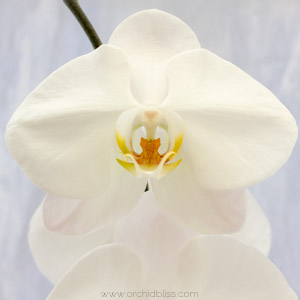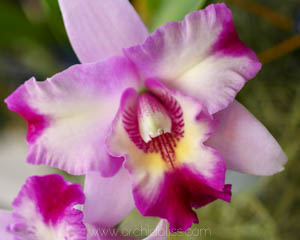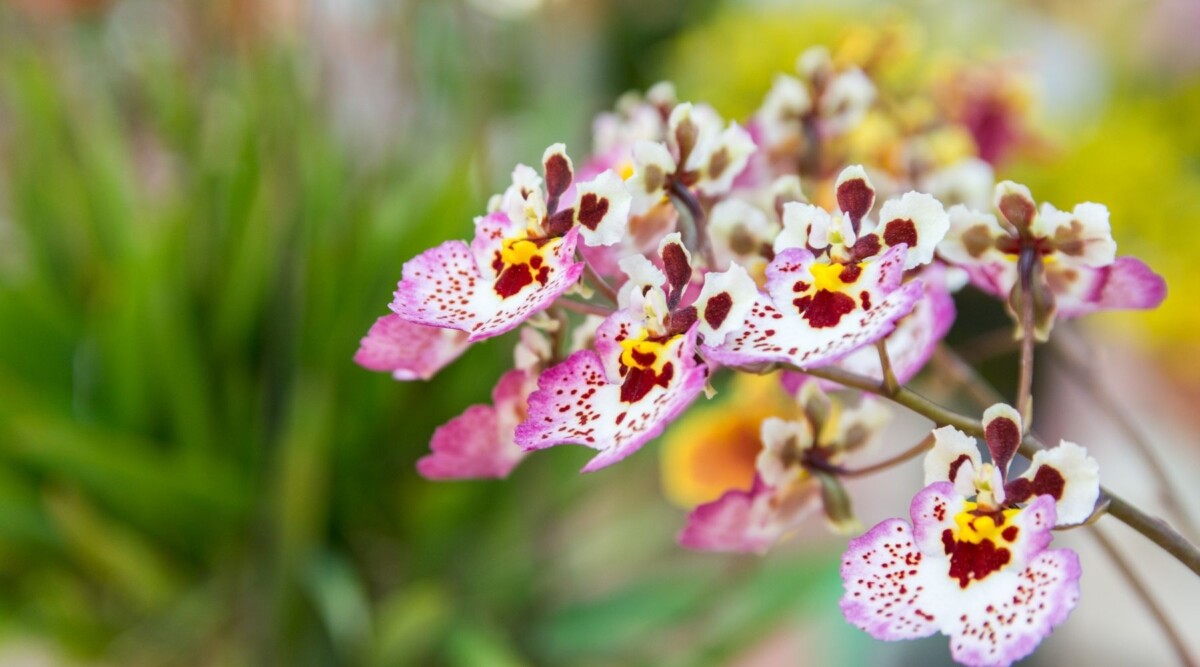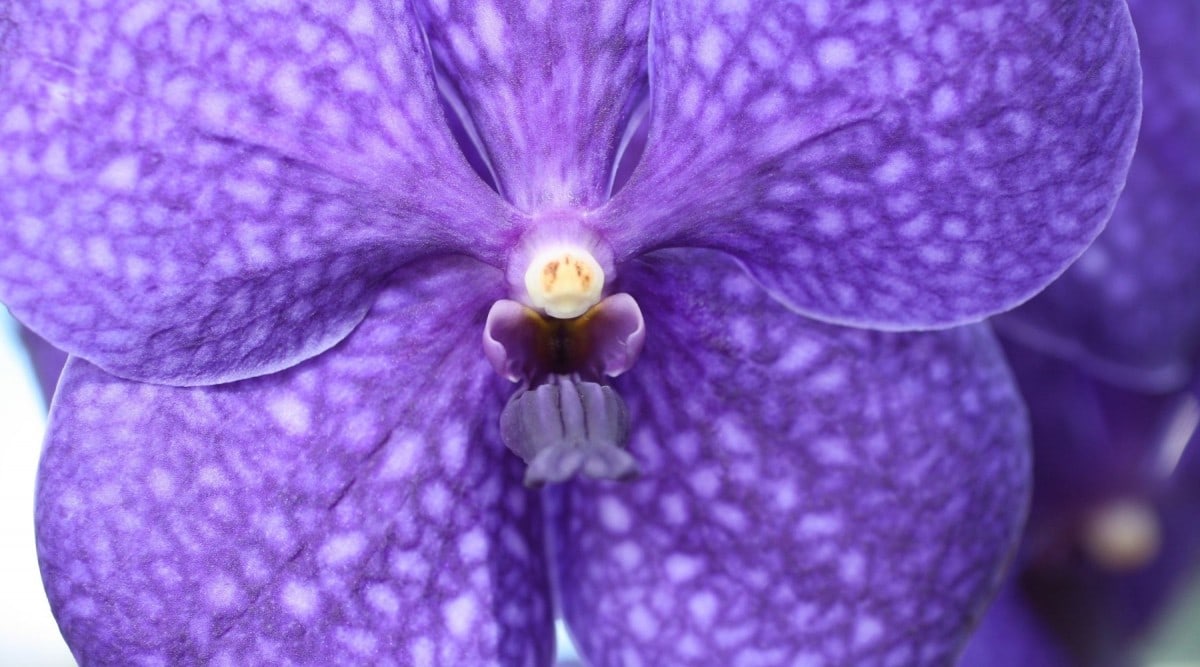Make an Educated Choice
Orchids are exquisite and dainty flowers that add to the beauty of any indoor or outdoor space. With an overwhelmingly wide range of species, many of them can thrive both potted and mounted. However, some species are better for mounting since it is closer to their natural habitat’s conditions.
The best orchids for mounting are those that grow on top of other plants like tree surfaces. The best species for mounting are Brassavolas, Vandas, Angraecums, Cattleyas, Tolumnias, and Phalaenopsis. The key to success with these orchids is providing the same conditions as their natural habitats.
In the rest of the article, we will talk about the cultivating requirements for these species. We’ll also talk about the best materials for mounting and how to mount your orchids in outdoor and indoor spaces.
Brassavola
The Brassavola orchid gets its name from an Italian botanist, Antonio Brassavola. It has nearly 20 different variations and hails from central and tropical South America. It’s a perfect genus for mounting as it’s an epiphyte, which means growing on top of other plants. Click here for your free Brassavola care card.
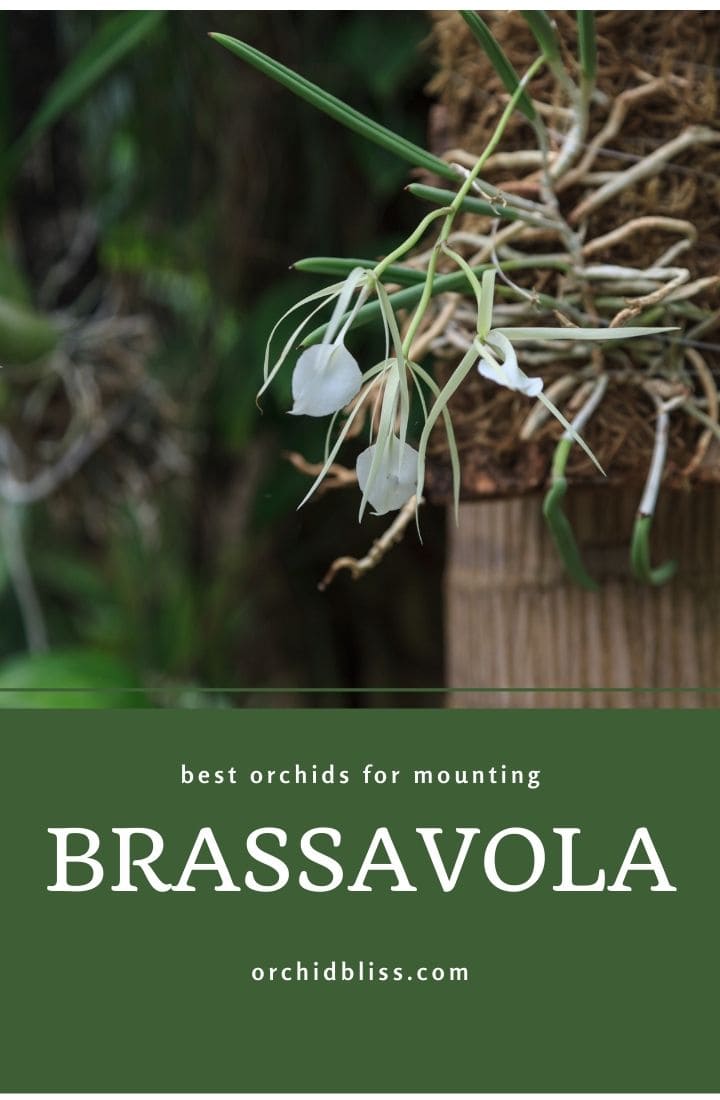
It has succulent leaves with a cluster of flowers and a long pseudobulb that stores water and food. The flowers have different colors ranging from yellow with brown spots, to white and green-white.
Due to their high tolerance for drought, fast and easy growth, and quick, fuss-free flowering, Brassavolas are ideal for beginners.
Brassavola responds well to mounting, especially on fern plaques or baskets. Some species outgrow their baskets or mounting containers. But they don’t need remounting; instead, multiply the plant stock by taking divisions and planting them in a pot. The best mounting material for them is cork or coconut.
Watering
Mounted Brassavola needs frequent watering several times a week until it starts flowering. After that, water it when the soil is dry. It’s more tolerant to drought thanks to its tubular leaves, which prevent water from transpiring. If you see wrinkled leaves, water the plant immediately because it’s a sign of water stress.
Temperature and Light
When it comes to temperature, Brassavola thrives in warm environments. It prefers bright light, but it doesn’t like direct sunlight. So, the perfect place for it is a south-facing window. When the plant gets enough light, the leaves become mottled with reddish spots on them. But lack of enough light turns the leaves to solid green.
Vanda
Getting its name from Sanskrit, Vanda grows in many parts of the world, including China, the Philippines, India, and northern Australia. It loves heat and hangs from trees, cracks in cliffs, and rocks in its natural habitat, making it a perfect mounting choice. It’s a fussy plant with particular preferences, but if you remember them, you’ll have an easy job. It’s popular among beginners since it easily propagates and produces a wide range of hybrids. Click here for your free Vanda care card.
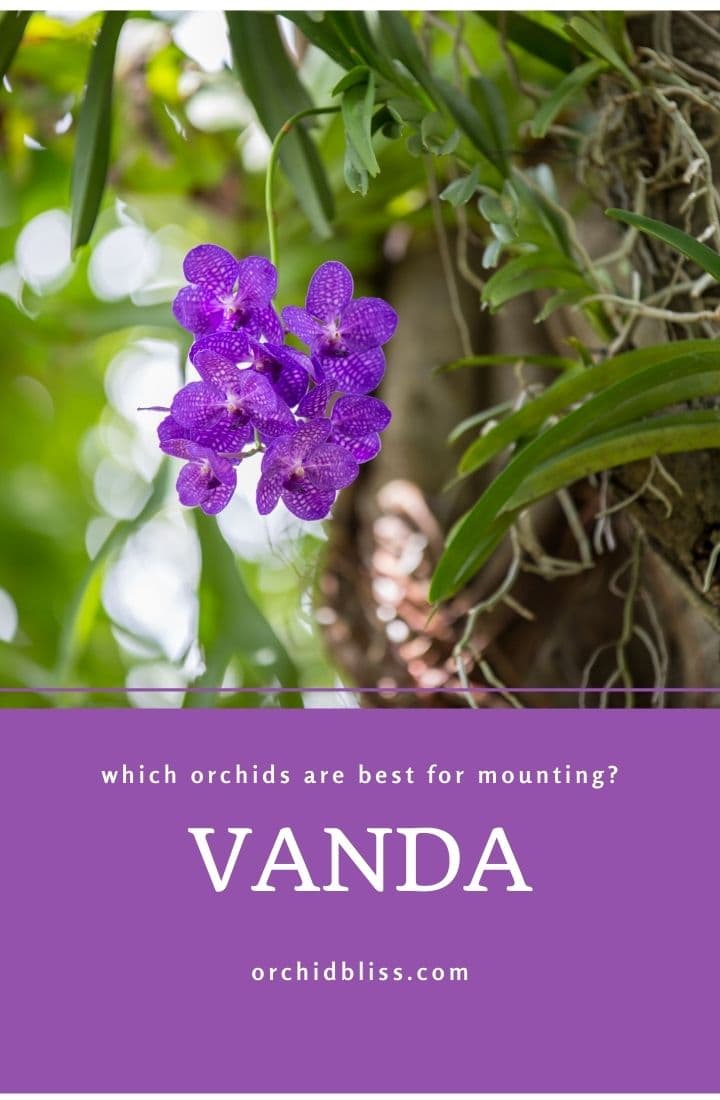
This epiphytic plant doesn’t need much soil to grow in and blooms multiple times a year. The flowers come in various colors, with thick and round foliage and a glossy sheen. It can grow up to 3 feet (one meter) tall with flowers as big as 3 to 10 centimeters (1 to 4 inches).
Temperature and Light
The perfect temperature range for Vanda is between 55˚F (13˚C) and 95˚F (35˚C). It could survive under lower temperatures, but it won’t bloom quickly. The only variety that can tolerate cooler temperatures is the Vanda coerulea.
The plant’s light needs depend on the species. The strap-leaved variety needs partial shade and protection from midday light. The terete variety, which has round leaves that look like pencils, needs bright light. If you keep it in the greenhouse, put it close to the window or suspend it from the glass roof.
Those kept in the living room should be put where they can take the highest amount of light. If the light changes with the seasons, take the plant to other rooms to get lots of light.
It has no cold tolerance as a warm-loving plant, so keep it at home. Aerial roots grow from thick fleshy bulbs and help the plant cling to the mounting area and get moisture from the air.
Vandas are fast-growing plants that overgrow their containers very quickly. So, it’s best to mount them on structures that allow their aerial roots to weave and coil around the substrate.
Angraecum
With over 200 species, these beautiful epiphytes have fleshy leaves with yellow, white, ochre, or green colors. Most of the species flower in the winter or spring and have flowers that release an intense scent at night.
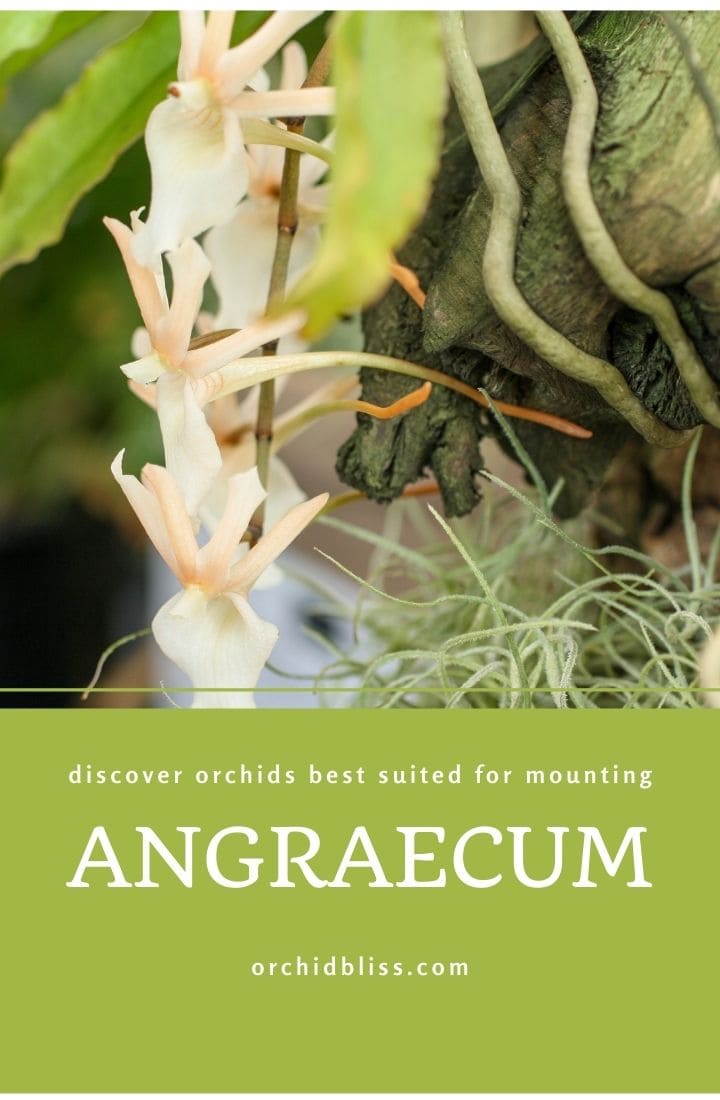
Humidity Levels
Since they are native to tropical regions, they love high light levels and humidity. But don’t put them under direct sunlight, or you’ll run the risk of scorching its leaves. The temperature needs vary significantly due to the wide range of species and habitats. But most varieties perform well at medium temperatures of 60-82˚F (15-28˚C).
Mounted Angraecums need more humidity than potted ones since their roots are more exposed to air. To meet the plant’s high humidity needs, use a medium for mounting that retains moisture longer, like sphagnum moss or coarse fir bark. However, the mature plant shouldn’t get soggy. So, wait until the medium dries for watering.
As an epiphytic plant, they easily grow mounted on the bark. They don’t grow quickly, so they don’t outgrow the medium for two or three years. After they become difficult to manage, you can replant them.
Click here to buy Angraecum orchids on Etsy.
Cattleya
Cattleyas are another epiphyte species that are widely popular among growers. Most of us are familiar with it as corsage orchids with fragrant flowers. But there are many variations to this widely recognizable species with many different hybrids since it’s easily interbred.
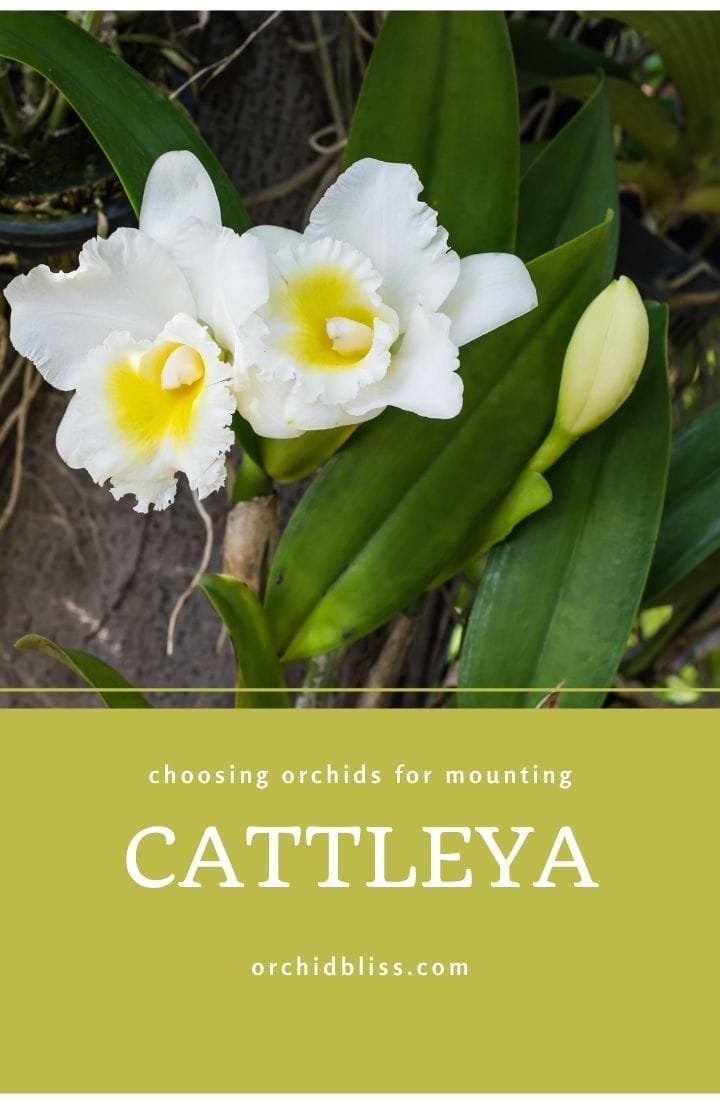
The large flowers range from 5 to 10 centimeters (2 to 4 inches) across and come in various colors, including white and different shades of cream, pink, yellow, and green. The trumpets are often large and in contrastive colors with the petals.
Cattleya is very easy to grow, thriving in almost any container, and of course, mounted. That’s why it’s great for beginners. You can grow it on cork bark, driftwood, or tree fern. The plant isn’t fussy and thrives in any medium as long as it has enough air circulation. It flowers all year round.
You should mimic its natural habitat conditions to help it grow and bloom. Since it grows in trees, where it’s subject to the open air, its roots shouldn’t be soggy but with enough moisture. That’s why mounting is perfect for it since it ensures enough aeration around the roots. Another advantage of mounting cattleyas is that they don’t outgrow the medium quickly and remain undisturbed for several years.
If you mount it on cork or driftwood, you can water it every day during the growing season as long as it has good aeration. When the days are shorter and colder in the winter, water the plants less frequently.
Light
Cattleyas are like other flowering plants when it comes to light requirements. They need plenty of light but protection from the direct sun at midday. The plant will let you know if it’s getting enough light by having medium green leaves. But if the light isn’t enough, the leaves will turn dark green, and too much light will cause the leaves to turn yellow.
Inadequate light can prevent the plant from flowering. In such cases, you’ll need to move it to areas where it can get more light. But make sure to move it gradually to adapt it to brighter areas and prevent the leaves from scorching.
Temperature
Hailing from tropical America’s mountainous regions, most cattleyas enjoy intermediate temperatures. The highest temperature they can thrive in is up to 90˚ F (32˚ C) during the daytime, and the lowest temperature they can tolerate during winter is up to 55F (12˚ C).
They can even withstand temperatures as low as 45˚ F (16˚˚C), provided that you protect them from the wind.
However, some species, such as the Brazilian Cattleya Violacea, can’t tolerate cold temperatures. So, to be on the safe side, make sure to keep the temperature over 50˚ F.
Phalaenopsis
These easy-to-grow orchids are equally popular among beginners and experienced gardeners. Native to the pacific islands and eastern Asia, this exquisite plant is also known as the moth orchid and experiences all-year-round rainfall and humidity in warm temperatures.
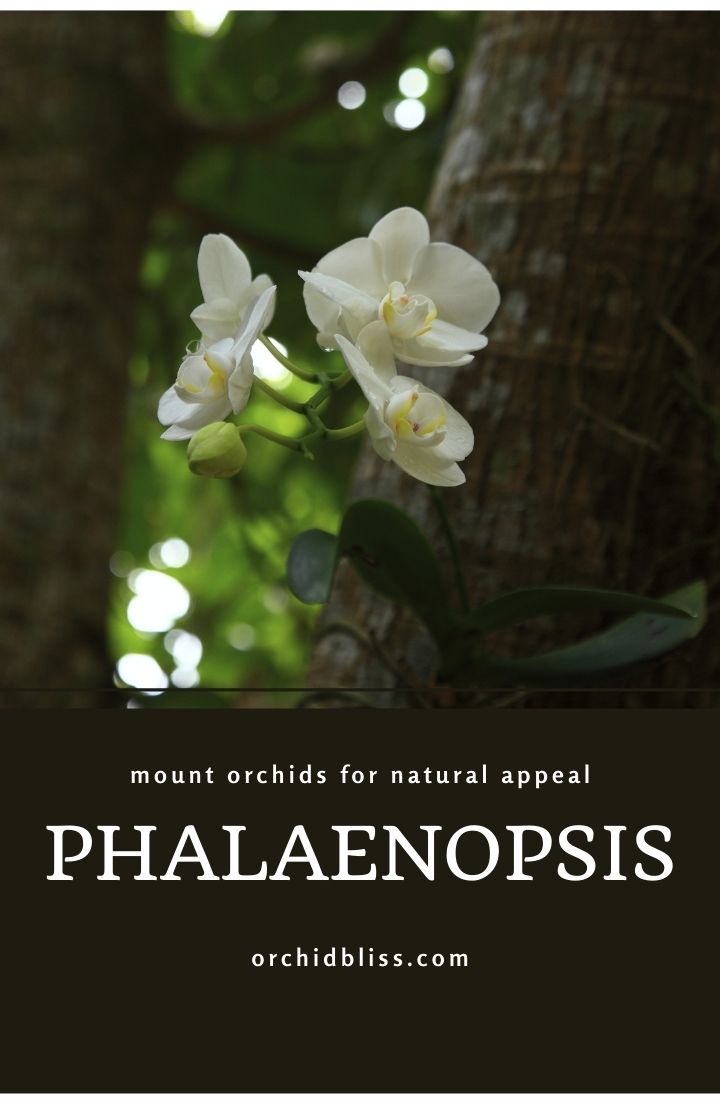
This epiphyte plant has a whole range of hybrids, most of which bear pink flowers in the winter. However, hybridization has created yellow and red blooms that flower in the spring and summer.
Phalaenopsis is a monopodial species, meaning it has only one growing point where leaves emerge. Although it has thick and succulent leaves, it can’t store water for arid times since they’re native to rainforests.
After your phalaenopsis finishes blooming, you may wonder where to cut the flower spike. To help you further, download my free cheat sheet to see where to cut the orchid flower spike after the blooms have faded to trigger re-blooming. Click here, for the cheat sheet. It’ll be super helpful.
Humidity and Watering
Since phalaenopsis orchids have hanging roots exposed to the air in their natural habitat, they’re ideal for mounting. They love humidity but not soggy roots. It’s better to provide the plant with its desirable humidity level using a humidifier.
When you water the plant, keep the crown, the central growing point, dry and moist-free. The plant could develop a serious fungal infection called crown rot if water builds up in the crown. So, make sure to dry out the crown with a paper towel if it accidentally gets wet.
Keeping the crown dry is easier if you keep the plant inside. Mounting the plant on cork bark or driftwood can provide the plant with conditions close to its natural habitat. This way, the leaves can hang down or tilt to one side, preventing water from collecting in the crown.
Light
Unlike most orchid species, phalaenopsis needs less light, making it a perfect indoor plant. It needs protection from direct sunlight, so a bright windowsill is all it needs light-wise. When the plants bloom, never change their place to give them more light. The spike tends to grow towards the light source, so if you frequently change the plant’s position, the spike will develop bends and twists to adapt itself.
As a tropical jungle plant, it loves humidity. So, make sure the plant never dries completely between watering. While you should avoid getting soggy roots, they should always be moist. If you provide them with adequate humidity, the flowers will live much longer, even for four months.
Dendrobium
Dendrobiums have strong stems and unique colors, which we see commonly sold as cut flowers in the retail trade. Their pseudobulbs, sophisticated water storage organs, have a leaf-like upright appearance called “canes.”
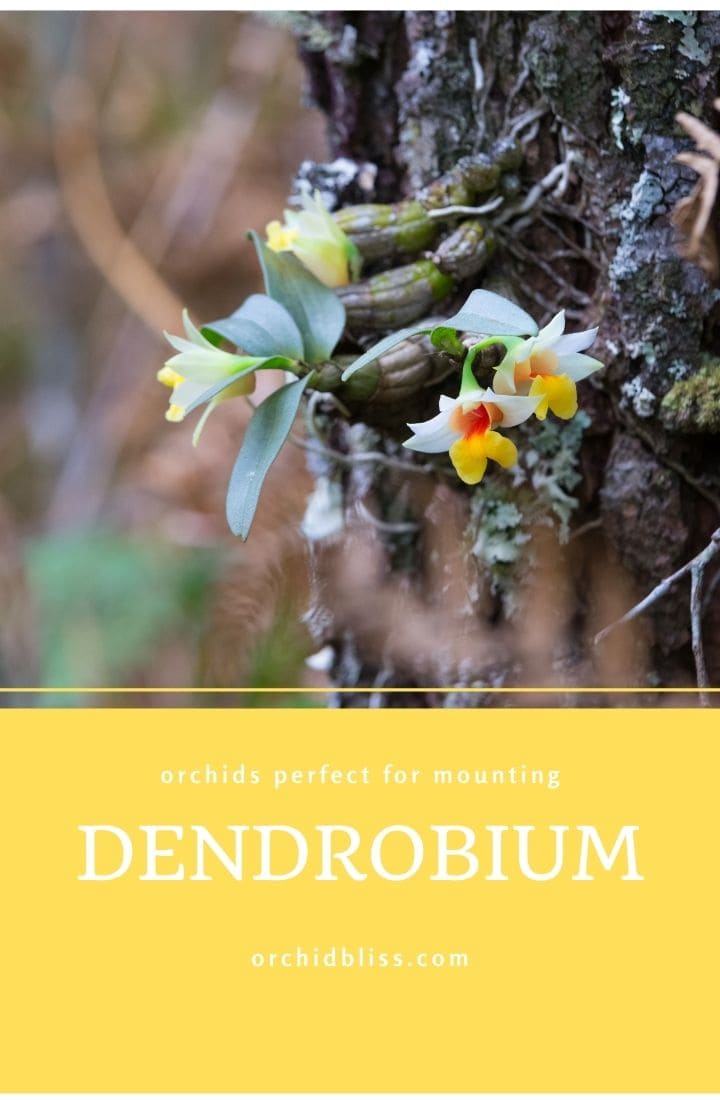
Native to many parts of Asia, it has over 1000 species spread in many tropical and subtropical regions with different climates. So, it isn’t easy to give a generalized description of the requirements for all of them. For example, some of them are adapted to dry climates, while others only thrive in moist environments.
The pendant dendrobium is the most common mounting species, which has hanging stems. This feature doesn’t make it the right candidate for potting. They are highly popular due to their fragrant and exquisite flowers in the spring. There are more than 50 species in this group, most of which are native to northeastern India.
As we mentioned, this group of dendrobiums grows mounted. If the species is large, it can get huge, which requires a sturdy mounting material like a cork slab or a plaque made of dense tree fern. Provide good air circulation for the mounted plant and water it every day, especially when it’s actively growing.
Temperature and Light
It grows in the spring and summer but stops growing in late fall and rests during the winter, with occasional leaves dropping. This group prefers mild to warm temperatures between 45-55˚F (7-13˚C) during the spring and summer. Temperatures lower than 50˚F (10˚C) may cause the leaves to drop.
During their active growth periods, they require plenty of light but not direct sunlight. You can keep them on the east, west, or shaded south windowsill. When the light is enough, the leaf color is medium olive-green. If you keep them in the greenhouse, they need 50 percent of full sunlight.
Watering
Watering is crucial to the growth and well-being of this group. As they’re subject to heavy rains in spring, summer, and early fall, they need ample watering during these times. However, you should reduce the water during late summer and winter when their natural habitats are rain-free and dry.
During the fall, when you see the plant has stopped producing new leaves, reduce watering gradually since the plant has entered the resting season. Too much watering can lead to problems like keikis production in the spring. Keikis are baby plants on the stems that appear instead of flowers.
Mexican Laelia
Also known as the star orchid, this genus is widely interbred with other species like Cattleya and Brassavola. There are two main branches of laelia: Mexican laelia and Brazilian laelia. Brazilian laelias better thrive in pots since they tend to grow to large sizes. Mexican laelias are better for mounting since they are epiphytes.
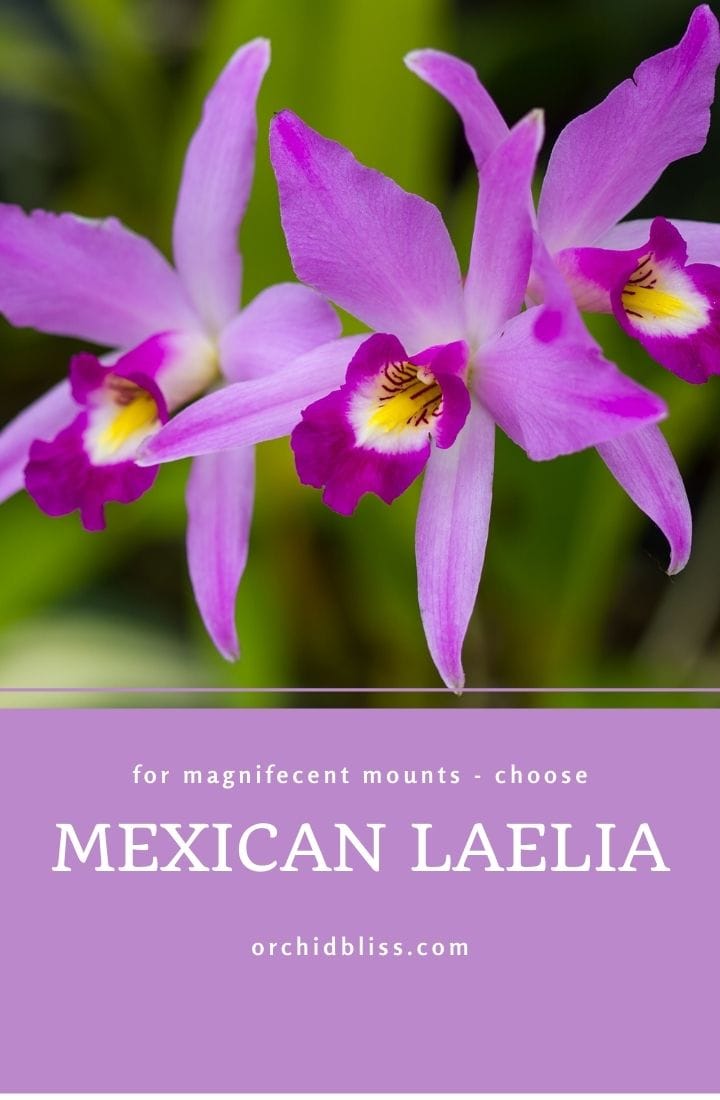
Laelias are easy to grow, low maintenance and are known for their bright, bold coloration. In terms of characteristics, they’re very close to the cattleya and grow in similar conditions. They love bright light but don’t like direct sun. They start to bloom in the winter after the growing season has ended.
Temperature
The temperature requirements depend on its natural habitat. They prefer cool, dry, and highly bright conditions if they come from the mountains. If they hail from the rainforest, they will appreciate warmer, moist summers and cool, dry winters. They have a resting season during the winter when they stop blooming.
Light
You can mount them on tree trunks, but make sure the tree doesn’t give it a full shade. If you mount it on a slab of cork, make sure to hang it in a south-facing place to give it the light it requires. The mounting medium should have excellent drainage to dry quickly after watering. During the growing season (spring to fall), provide more frequent watering and higher temperatures than the resting season.
Tolumnia
Tolumnia is another species for which mounting works better than potting. The flowering season is in the spring, with inflorescences ranging from 12 to 18 in (30 to 45 cm) in size. Click here for your free Tolumnia care card.
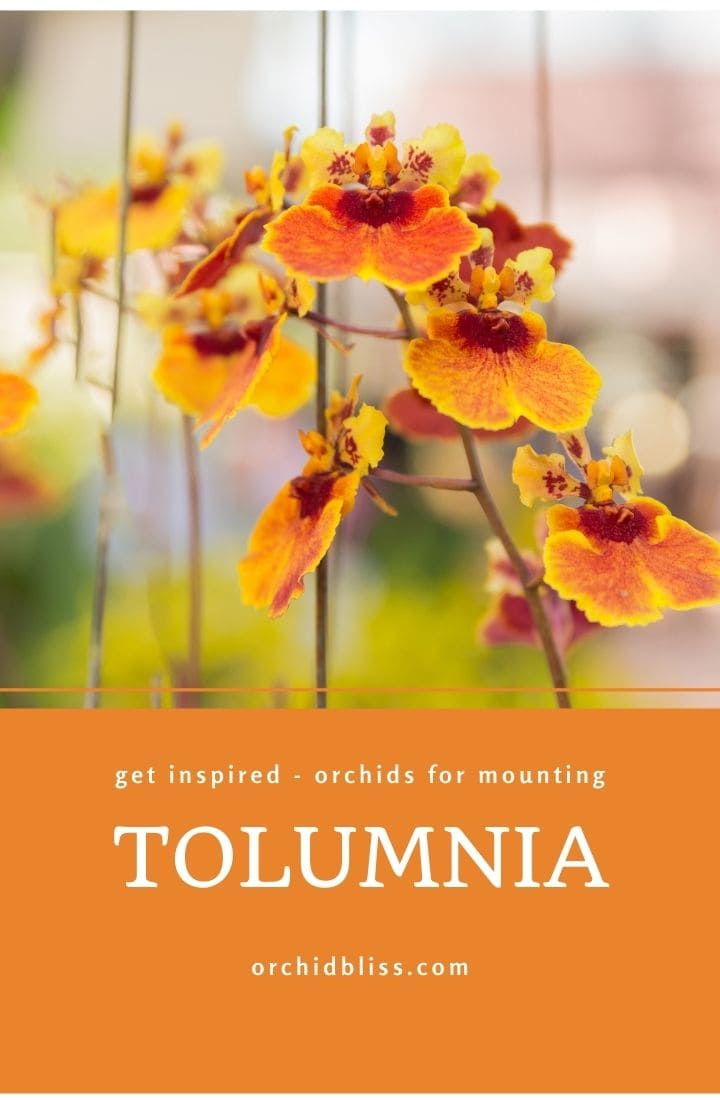
Compared to other species, it takes much shorter to bloom (about two and a half years between pollination and flowering). It’s highly adaptable to many different conditions in terms of light.
Temperature
The key to success with this variation is understanding its natural habitat. Native to the Caribbean Basin, it needs bright light. Daily rain showers are followed by winds, which prevent the plants from being wet for a long time. So, with this orchid, watering and air circulation are critical. Make sure to wait until the plant dries and then water it. The perfect temperature for them is between 60-85˚ F (15-29˚C).
Humidity
The best humidity levels are 50 to 70 percent. You can mist the plant daily if it’s inside but don’t do the misting during hot hours of the day. Water can collect in the leaves and get hot, leading to severe damage to the plant.
Light
The plant’s light requirements fall between those of phalaenopsis and cattleyas. As a rule of thumb, the light is suitable if you can see shadows on the orchid bench. Plus, the plant will stop flowering if the light levels aren’t enough. Make sure to gradually move it to a brighter area to prevent it from burning.
You might see pests like scale and mealybugs on these orchids. So, always check your plant for these pests; if you detect any, treat it with insecticidal soap. Since tolumnia prefers dry conditions, diseases don’t happen much.
The Best Materials for Mounting Orchids
Durability is an important feature to consider when choosing your mount. Beauty and functionality are other features. Choose the right size material to avoid remounting for several years.
You could use commercially produced materials or cut-off branches of different trees. Driftwood, cork oak bark, and oak branches are suitable choices to support the mounts. Driftwood comes from both freshwater lakes and the sea, which is more beautiful but contains salts. The salt can harm the plant’s roots. So, if you insist on using sea driftwood, you can soak it in fresh water and change the water multiple times to wash away the salt.
With wood from pruned trees, leave it for several months so that it completely dries. Fruit-bearing trees like apples and grapes are good choices.
Whatever wood you use, make sure to avoid pressure-treated woods coated with preservatives and walnut wood. The wood has to be unpainted; otherwise, the orchid plant won’t thrive.
One of the most long-lasting wood supports is cork oaks’ bark, lasting at least ten years. Cork bark slabs have lots of crevices in which orchid roots can grow.
For outdoors with high humidity, use cypress bark slabs, which are more resistant to decay.
Tree fern slabs are soft and can retain moisture better. They are dense and perfect for many types of epiphytic orchids.
You can add a small chunk of sphagnum moss on the support and put the orchid roots on it for dry areas. This way, you can preserve moisture for more extended periods.
Pros of Mounting
While you can always opt for pots, mounting can have many benefits that work equally for beginners and experienced growers. Here are some advantages of mounting orchids:
It Looks More Natural
Many epiphytic orchids grow on tree branches in their natural habitats. Mounting them would be following nature’s way while potting them will confine their roots. Plus, many orchid species have their flowers hanging from their stems, providing the best moisture conditions and preventing water from collecting at the roots. Mounting doesn’t require staking, which gives your plant a more natural look.
Mounts Are More Long-lasting
Orchids that grow quickly need frequent repotting since they outgrow their pots. Their roots can grow out of the pot, which means repotting is necessary. On the other hand, mounted orchids can last several years on their slab.
Cons of Mounting
But mounting orchids isn’t without drawbacks, especially for hobbyists who may not have enough time to take care of them. Compared to potted orchids, mounted orchids’ roots dry out more quickly. So you need to water them more frequently. Additionally, they need more humidity in the air, so you should spend some time watering your plants every day.
Growing Orchids Outside
Temperature and humidity are the most important factors for mounting orchids outside. First, determine their exact levels in your area during different seasons and choose the best type of orchid that thrives in those conditions.
You should then find the best location: a tree stump with the right amount of light. Most orchids don’t tolerate direct sunlight but can’t tolerate shade, either.
Now, you can attach the orchid to the tree trunk. Make sure the orchid has enough roots so that it can cling to its host. Place the plant on the tree and wrap it with a cotton string, which will decompose after some time. Avoid fastening the string too tight, or you’ll damage the plant. The plant will attach to the host fully in a year.
Mounting an orchid outside doesn’t need a medium between the plant and the tree. After all, it can cause the root to decay because it preserves moisture too much.
However, you need to water the plant more frequently since there’s nothing to retain moisture.
Mounting Orchids Inside
Orchids that are mounted inside create a beautiful display. They can also stay healthier by having access to ideal conditions.
The mounting process is fairly easy. Put the mount in water for a few hours. Carefully inspect the orchid’s roots, clean it from any potting material, and cut off dead roots.
Wrap the roots with moist sphagnum moss to prevent the plant from getting shocked by the transplant. Place the root on the mount and tie it with floral wire.
And if your mounted orchid outgrows its slab, you don’t need to remount it since it can damage the delicate roots. Instead, you can add another slab or piece of wood to the previous one. This way, the roots will expand to the new mounting material without compromising the plant’s health.
Be sure to fertilize your plant regularly by spraying fertilizer over the leaves. Or, you can make a diluted fertilizer solution and submerge the mount in it.
Conclusion
With more than 28,000 species, orchids are among the most diverse plant families, and they make beautiful additions to any home, garden, or greenhouse. The epiphytic species, the ones that grow on top of other plants, are ideal for mounting.
To help them experience the same conditions as their natural habitats, make sure to meet their light, temperature, and light requirements.
Brassavola, Angraecum, Cattleya, Vanda, Tolumnia, and Phalaenopsis are among the best species you can grow mounted.
After going through all the work of mounting your orchid, I’ll show you how to avoid overwatering. Improper watering is often the cause of a droopy, unhealthy orchid. Click here to grab your cheat sheet to learn how to grow healthier orchids. It will be super helpful.
Related articles
13 Surefire Ways to Bloom and Grow Cattleya Orchids
If you thought Cattleyas were too tricky, think again
ReadSources
- Flower Power: A Comprehensive Guide to Orchids
- Home of Houseplants: Mounting Orchids and Caring for Mounted Orchids
- The Spruce: Growing Orchids on Mounts
- The Spruce: 20 Types of Orchids to Use as Houseplants
- American Orchid Society: Lending Support
- Orchid Fetish: Laelia Orchid

